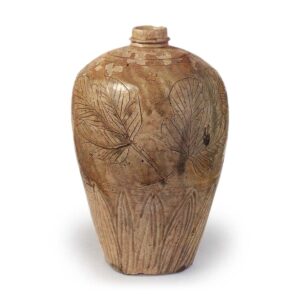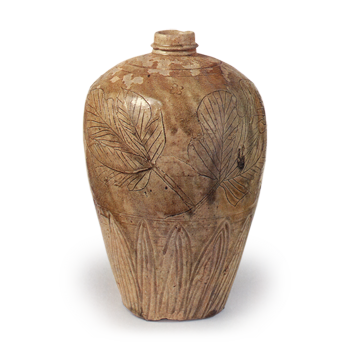
Excavated from Josama Kiln, Josama-cho, Seto City, Aichi Prefecture, Japan
14th century
Height 26.2cm, Bowl diameter 3.4cm, Body diameter 16.6cm, Bottom diameter 9.6cm
Aichi Prefectural Ceramic Museum
This is a type of so-called “plum vase” type vase, the most widely produced of all Kosedo vases, along with “four-mimi” vases. Unlike the slender ash-glazed vase, this type of vase is shorter, has a single projecting band in the center of the mouth, and has a rounded mouth rim. Needless to say, this vase is an imitation of a Chinese Song dynasty vase, but it is thought to have appeared later than the previous vase, in the late Kamakura period.
The clay used for this vase is yellow and slightly sandy, and the vessel was shaped by grinding after cord-wrapping. The body is divided into three sections, with two sunken lines flanking the shoulders, and the upper and lower sections are decorated with a sealed flower and plum and flower design. The central part is decorated with two pairs of large and small leaves, and the lower half is decorated with 16-petaled lotus petals carved in the round shape. The nail carving and the thick round carving in the lower half of the bowl were not at their peak in terms of design, and it is thought to have been made around the period of the Nanboku-cho (Northern and Southern Dynasties). The ash glaze is stable with a large amount of feldspar and has a slightly oxidized yellowish-green color. This is one of the finest examples of Kosedo pottery from its peak period.



